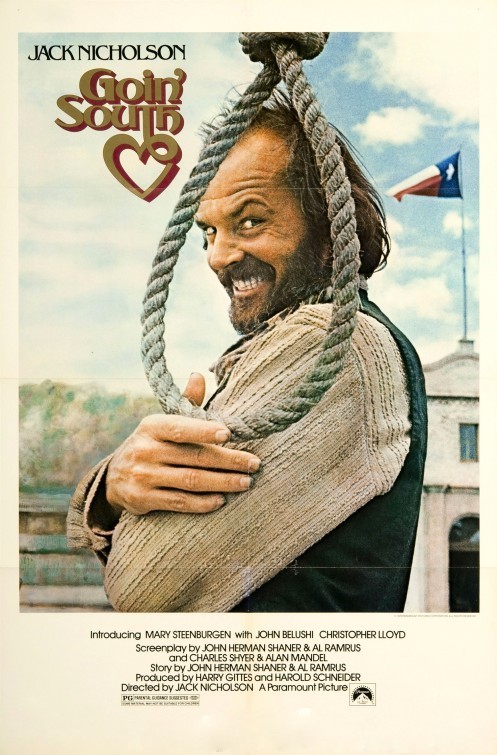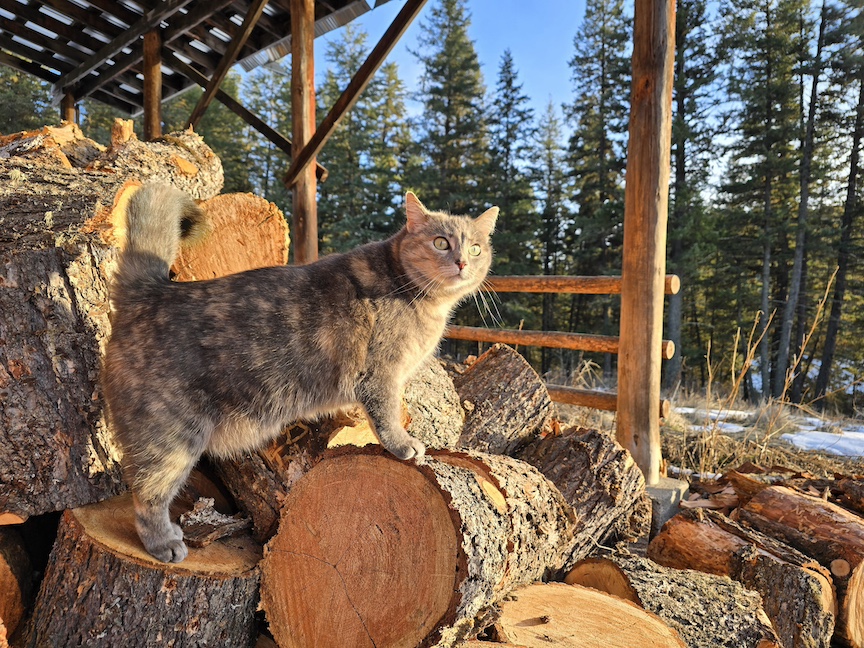Starring: Jack Nicholson, Mary Steenburgen, Christopher Lloyd, John Belushi
Director: Jack Nicholson
Released: 1978
Mood: If you’ve been working too hard and feel like you have no brain cells left but desperately want to cheer up with a Western so you need it to be easy yet pleasing.
I didn’t have high expectations for Goin’ South, coming off a string of disappointing Westerns. Thank the movie gods, because this movie is a hidden Western gem.
It sat on my Amazon Prime list for YEARS before I got around to it. I only picked it because I’d just come home from a mentally taxing Pathfinder session – I am many kinds of nerd – but still wanted to watch a Western, and it looked like easy viewing.
Goin’ South is equal parts Western and rom-com, and gives you a quirky take on both genres. It boasts a star-studded cast, but they weren’t all stars then, so it’s probably way more exciting for those of us discovering it now than it was at the time of its release (at which point it flopped horribly).
It’s not a perfect movie, and the ending is kind of like, “oh, that was it?” But there’s a lot of fun here, and it doesn’t ask too much of your brain to follow along.

Goin’ South begins with “third-rate” outlaw Henry Moon (Jack Nicholson) on the run, galloping away from a posse led by Deputy Towfield (Christopher Lloyd). Moon crosses a river and leaps off his horse to celebrate, dancing and mocking the posse because he’s on Mexican soil.
These late 1860s Texas lawmen don’t care for things like borders, so they nab Moon and haul him back for a good ol’ public hangin’. Right before he mounts the gallows, he learns a vital piece of information. So many men didn’t come back from the Civil War that this little Texas town has an ordinance: any convicted man can be freed by a land-owning woman willing to marry him.
Moon pleads his case in an impassioned monologue of that trademark Nicholson style. He’s plucked at the last possible moment by young Julia Tate (Mary Steenburgen).
But Julia is no desperate housewife. She puts Moon to work in her would-be goldmine. Meanwhile, Moon’s old gang and the spurned Deputy Towfield are on the prowl, determined to get even. It’s double-cross after double-cross as everybody clamours to come out on top.
![]()
I expected Goin’ South to be all cheeky and slapstick, like The Villain. But aside from a few choice pranks, like Moon dumping a bucket of horse urine on Towfield’s head and Steenburgen trying to decapitate Nicholson atop a buggy, the humour is largely within the dialogue and the delivery.
It’s got a solid story at its core, and surprisingly realistic sets and costumes that immerse you in the period.
What Goin’ South truly has goin’ for it, though, is that it was made at a pivotal point in several of its actors’ careers. So you get brilliant performances from a bunch of people who you know now as major stars. Their fresh energy radiates from the screen, which makes up for its slower pace.
- Jack Nicholson had done Easy Rider, Chinatown, and One Flew Over the Cuckoo’s Nest, and was booked to start shooting The Shining
- This was Mary Steenburgen’s first-ever role!
- Christopher Lloyd transitioned from theatre to film, and got his start in One Flew Over the Cuckoo’s Nest – but was a few years off yet from becoming a household name in Taxi and Back to the Future
- John Belushi had become a fan favourite on Saturday Night Live, and in 1978 he starred in both Goin’ South and National Lampoon’s Animal House
- Danny DeVito, who plays a small role in Moon’s gang, had done One Flew Over the Cuckoo’s Nest and, like Lloyd, was still a few years away from Taxi and his massive popularity in ‘80s comedies
Nicholson just LOOKS like an outlaw. It’s those eyebrows, that unkempt hair, and that perpetually sinister smile. He fits right into the role, hamming it up as the centre of attention, but still allowing Moon some peaks and valleys.
Steenburgen shows you exactly why she was destined for greatness (and a shitload of awards). She’s equal parts rigidly stubborn and vulnerable. She gives you this resilient woman with a dark sense of humour under the surface.
There was a lot of negativity in early reviews, saying that Nicholson needed to be more charming, more of a leading man, and that Steenburgen didn’t have enough range. But the characters are a selfish, boisterous outlaw and a prim Southern virgin. Like, realistically, how much growth and suaveness can you expect from this kind of man – or any man? And why should losing her virginity have to drastically change Julia’s personality?
She rescued him from the gallows to do physical labour. He used to rob banks. They learn to get along. I’m sure there were, and are, plenty of worse marriages.
Belushi is the only one who kind of disappears, apparently because he made a lot of demands on set and his role may have shrunk. Critics at the time said Goin’ South would have benefitted from way more Belushi and his brand of humour, which is pretty stupid since they also said Nicholson was too silly.
Sure, I would have loved to see more of Belushi. The man was hilarious. But he was also playing a ‘fat, lazy’ Latino deputy, and who knows where that would have gone with more screentime. At least with the way it turned out, we can hope he was half white…
![]()
Goin’ South doesn’t have a true protagonist or a villain – Nicholson is kind of both, and also neither – nor does it have a gunslinger, a saloon fight, a trusty steed, or a cowboys vs. ‘Indians’ rivalry. Everybody just kind of has good and bad traits, which is a typical plot point for ‘70s Westerns.
But rather than wallow in being UN-Western to prove a point, Goin’ South focuses on telling a funny story through longer scenes with its characters. It’s not always successful, but you still have a good time.
It was shot in Durango, Mexico, on a Western town set built by John Wayne’s son. That classic Western vibe grounds the ridiculous moments, and makes everything feel more authentic.
There’s one scene that starts to turn wrong, and even Wikipedia mistakenly describes it as a sexual assault. It’s not, it’s a misdirection during which Moon ties Mary up so he can don a disguise and steal her horse and buggy.
Honestly, the one thing I’d change is more screentime for Christopher Lloyd, and more focus on him hating Moon for escaping the noose and stealing his crush. Lloyd stands out in every scene here, and could have better balanced Nicholson’s dominance of the plot.
Apparently the original stars Paramount had lined up were Elliot Gould and Candice Bergen. Would that have made it better? Nah. I think this is as good as it gets, Nicholson movie reference intended. And the result is a fun distraction for fans of any of these actors.


